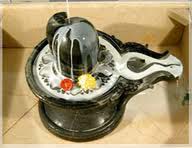| Maha Shivaratri |
 |
All over India, Maha Shivratri occurs on the 14th night of the new moon during the dark half of the month of Phalguna. On a moonless night in February every year, occurs the night of Shiva, the destroyer. This is the night when He is said to have performed the Tandava or the dance of primordial creation, preservation and destruction.
Devotees of Shiva fast during the day and maintain a long vigil during the night. In temples all across the country, bells ring, sacred texts are chanted and traditional offerings of leaves and milk are made to the Shiv lingam, the phallic symbol of the god. There is a legend behind Shiva's phallic form. It is believed that once Brahma and Vishnu, the two pillars of the holy Trinity were having an argument as to who was supreme. Brahma declared himself to be the Creator of all and thus more revered. Vishnu claimed that since he was the Creator and the Destroyer, he commanded more respect. At that moment a huge lingam ablaze with flames appeared from nowhere. Both the gods were so overwhelmed by its constantly increasing size, that they forgot their quarrel and decided to determine its size. Vishnu took the form of a boar and went to the netherworld while Brahma in the form of a swan ascended to the skies. Neither could ascertain the size. Just then, Shiva appeared out of the lingam and proclaimed that he was the progenitor of both of them. He was the Creator, Preserver and the Destroyer. He demanded that thereafter he be worshipped in his phallic form, the lingam.
|
 |
On the day of Shivratri, the lingam is bathed with the five sacred offerings of a cow, called the panchagavya - milk, sour milk, urine, butter and dung. Thereafter the five foods of immortality - milk, clarified butter, curd, honey and sugar - are placed before the lingam. Dhatura and jati, though poisonous fruits, are believed to be sacred to Shiva and thus offered at his temple. Eleven is considered to be the sacred number of the Lord. Devotees keep a fast (vrat) on Shivratri and observe strict rules, for vardan (boon). |
| Special celebrations are held at important Shiva temples at Chidambaram, Kalahasi, Khajuraho and Varanasi. Worship of Shiva is to release the worshipper from the cycle of birth and rebirth. In Kashmir, the festival is held for 15 days; the thirteenth day is observed as Herath, a day of fast followed by a family feast.
|
|
|
| Religions |
In India, religion is a way of life. It is an integral part of the entire Indian tradition. For the majority of Indians, religion permeates every aspect of life, from common-place daily chores to education and politics. Secular India is home to Hinduism, Islam, Christianity, Buddhism, Jainism, Sikhism and other innumerable religious traditions. Hinduism is the dominant faith, practised by over 80% of the population. Besides Hindus, Muslims are the most prominent religious group and are an integral part of Indian society. In fact India has the second largest population of Muslims in the world after Indonesia.
|
| Read more about Indian Religions |
|
|
